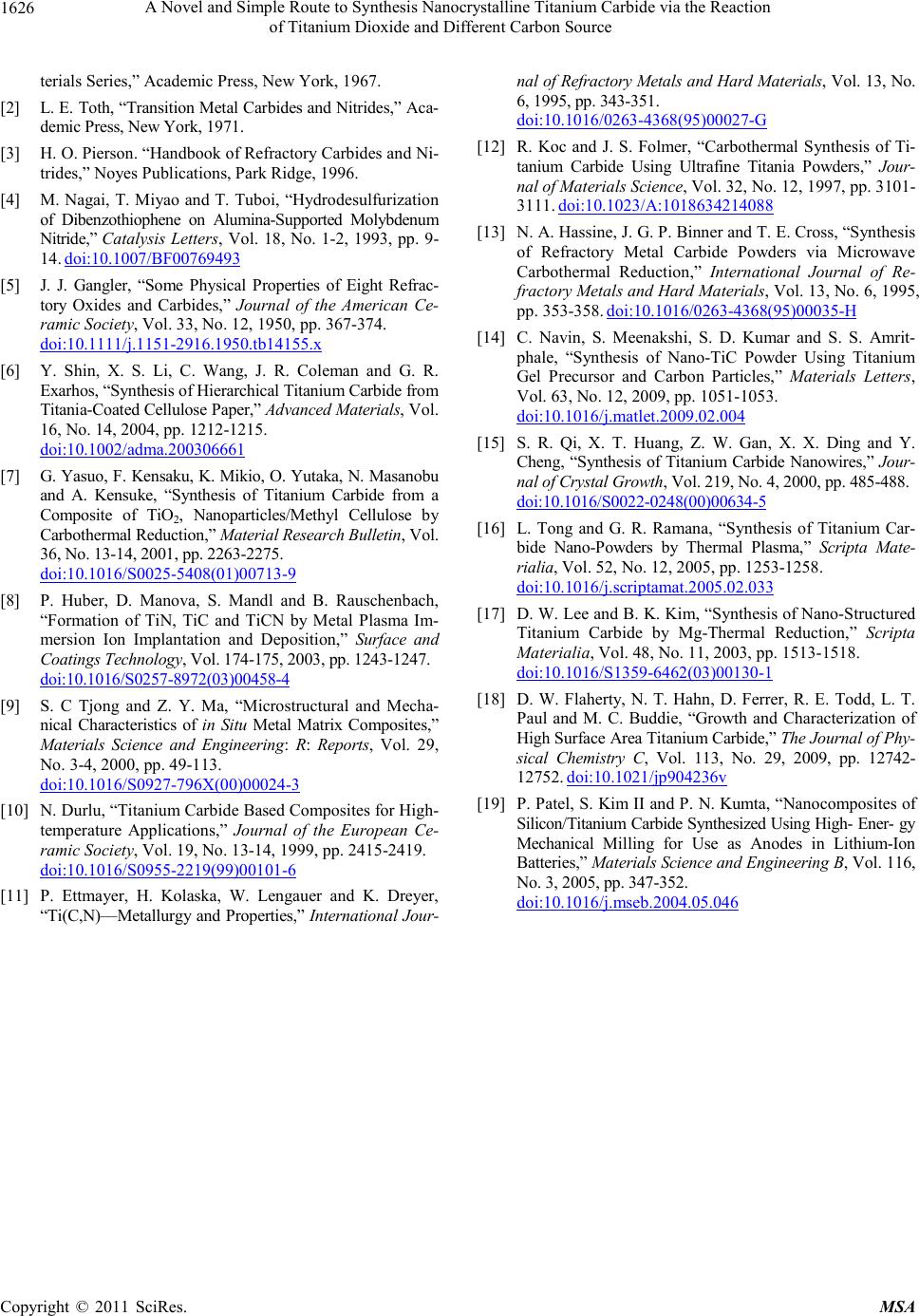
A Novel and Simple Route to Synthesis Nanocrystalline Titanium Carbide via the Reaction
of Titanium Dioxide and Different Carbon Source
Copyright © 2011 SciRes. MSA
1626
terials Series,” Academic Press, New York, 1967.
[2] L. E. Toth, “Transition Metal Carbides and Nitrides,” Aca-
demic Press, New York, 1971.
[3] H. O. Pierson. “Handbook of Refractory Carbides and Ni-
trides,” Noyes Publications, Park Ridge, 1996.
[4] M. Nagai, T. Miyao and T. Tuboi, “Hydrodesulfurization
of Dibenzothiophene on Alumina-Supported Molybdenum
Nitride,” Catalysis Letters, Vol. 18, No. 1-2, 1993, pp. 9-
14. doi:10.1007/BF00769493
[5] J. J. Gangler, “Some Physical Properties of Eight Refrac-
tory Oxides and Carbides,” Journal of the American Ce-
ramic Society, Vol. 33, No. 12, 1950, pp. 367-374.
doi:10.1111/j.1151-2916.1950.tb14155.x
[6] Y. Shin, X. S. Li, C. Wang, J. R. Coleman and G. R.
Exarhos, “Synthesis of Hierarchical Titanium Carbide from
Titania-Coated Cellulose Paper,” Advanced Materials, Vol.
16, No. 14, 2004, pp. 1212-1215.
doi:10.1002/adma.200306661
[7] G. Yasuo, F. Kensaku, K. Mikio, O. Yutaka, N. Masanobu
and A. Kensuke, “Synthesis of Titanium Carbide from a
Composite of TiO2, Nanoparticles/Methyl Cellulose by
Carbothermal Reduction,” Material Research Bulletin, Vol.
36, No. 13-14, 2001, pp. 2263-2275.
doi:10.1016/S0025-5408(01)00713-9
[8] P. Huber, D. Manova, S. Mandl and B. Rauschenbach,
“Formation of TiN, TiC and TiCN by Metal Plasma Im-
mersion Ion Implantation and Deposition,” Surface and
Coatings Technology, Vol. 174-175, 2003, pp. 1243-1247.
doi:10.1016/S0257-8972(03)00458-4
[9] S. C Tjong and Z. Y. Ma, “Microstructural and Mecha-
nical Characteristics of in Situ Metal Matrix Composites,”
Materials Science and Engineering: R: Reports, Vol. 29,
No. 3-4, 2000, pp. 49-113.
doi:10.1016/S0927-796X(00)00024-3
[10] N. Durlu, “Titanium Carbide Based Composites for High-
temperature Applications,” Journal of the European Ce-
ramic Society, Vol. 19, No. 13-14, 1999, pp. 2415-2419.
doi:10.1016/S0955-2219(99)00101-6
[11] P. Ettmayer, H. Kolaska, W. Lengauer and K. Dreyer,
“Ti(C,N)––Metallurgy and Properties,” International Jour-
nal of Refractory Metals and Hard Materials, Vol. 13, No.
6, 1995, pp. 343-351.
do i:10.1016/0263-4368(95)00027-G
[12] R. Koc and J. S. Folmer, “Carbothermal Synthesis of Ti-
tanium Carbide Using Ultrafine Titania Powders,” Jour-
nal of Materials Science, Vol. 32, No. 12, 1997, pp. 3101-
3111. doi:10.1023/A:1018634214088
[13] N. A. Hassine, J. G. P. Binner and T. E. Cross, “Synthesis
of Refractory Metal Carbide Powders via Microwave
Carbothermal Reduction,” International Journal of Re-
fractory Metals and Hard Materials, Vol. 13, No. 6, 1995,
pp. 353-358. doi:10.1016/0263-4368(95)00035-H
[14] C. Navin, S. Meenakshi, S. D. Kumar and S. S. Amrit-
phale, “Synthesis of Nano-TiC Powder Using Titanium
Gel Precursor and Carbon Particles,” Materials Letters,
Vol. 63, No. 12, 2009, pp. 1051-1053.
doi:10.1016/j.matlet.2009.02.004
[15] S. R. Qi, X. T. Huang, Z. W. Gan, X. X. Ding and Y.
Cheng, “Synthesis of Titanium Carbide Nanowires,” Jour-
nal of Crystal Growth, Vol. 219, No. 4, 2000, pp. 485-488.
doi:10.1016/S0022-0248(00)00634-5
[16] L. Tong and G. R. Ramana, “Synthesis of Titanium Car-
bide Nano-Powders by Thermal Plasma,” Scripta Mate-
rialia, Vol. 52, No. 12, 2005, pp. 1253-1258.
doi:10.1016/j.scriptamat.2005.02.033
[17] D. W. Lee and B. K. Kim, “Synthesis of Nano-Structured
Titanium Carbide by Mg-Thermal Reduction,” Scripta
Materialia, Vol. 48, No. 11, 2003, pp. 1513-1518.
doi:10.1016/S1359-6462(03)00130-1
[18] D. W. Flaherty, N. T. Hahn, D. Ferrer, R. E. Todd, L. T.
Paul and M. C. Buddie, “Growth and Characterization of
High Surface Area Titanium Carbide,” The Journal of Phy-
sical Chemistry C, Vol. 113, No. 29, 2009, pp. 12742-
12752. doi:10.1021/jp904236v
[19] P. Patel, S. Kim II and P. N. Kumta, “Nanocomposites of
Silicon/Titanium Carbide Synthesized Using High- Ener- gy
Mechanical Milling for Use as Anodes in Lithium-Ion
Batteries,” Materials Science and Engineering B, Vol. 116,
No. 3, 2005, pp. 347-352.
doi:10.1016/j.mseb.2004.05.046